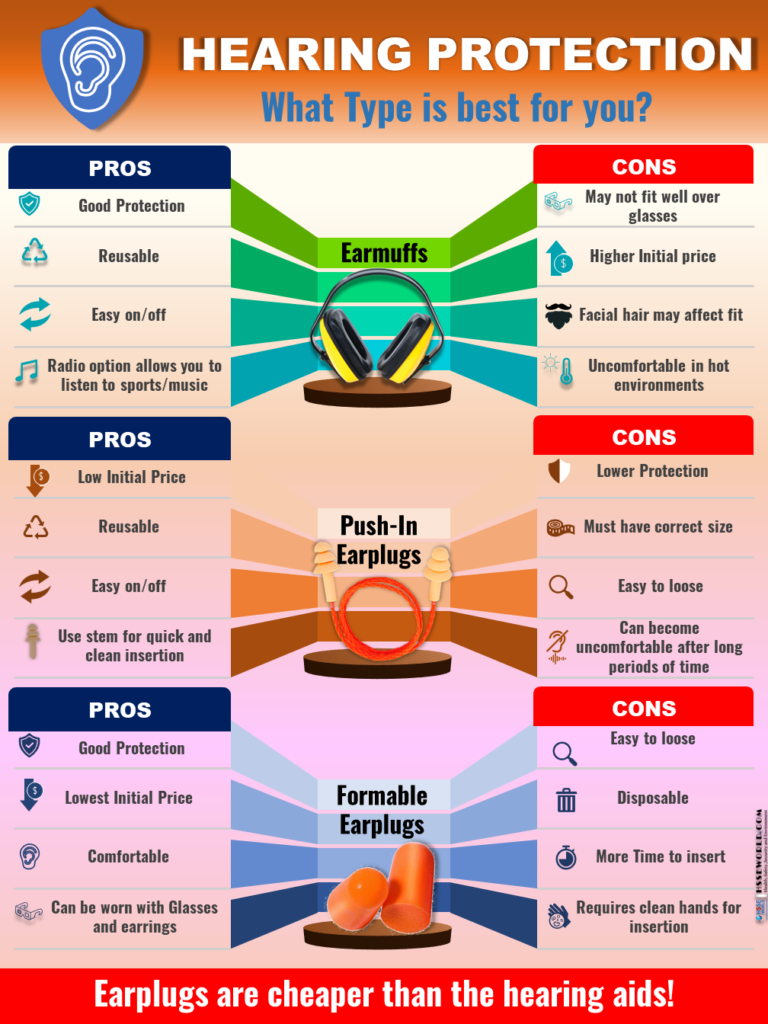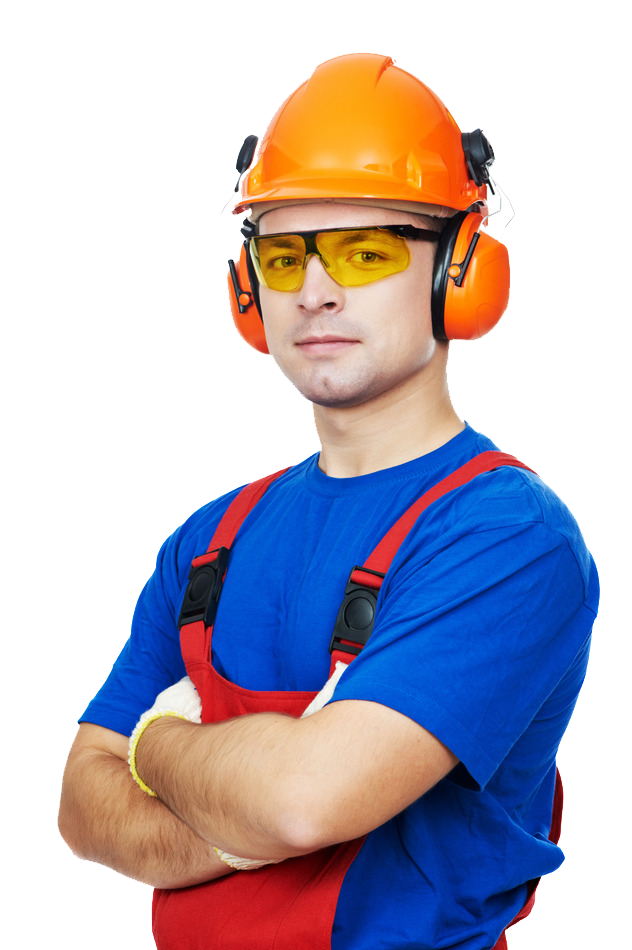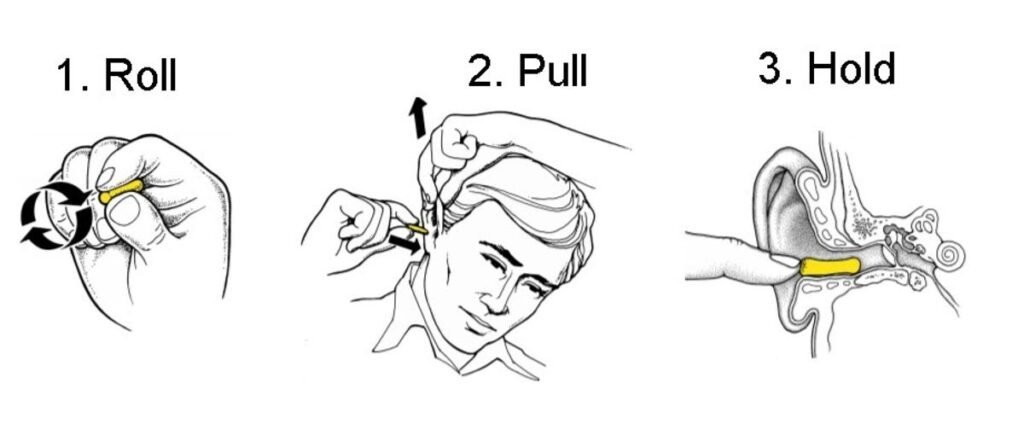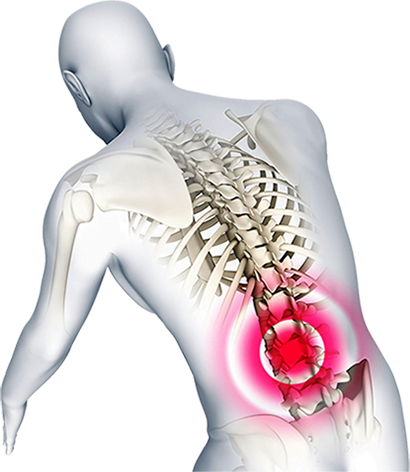The safest way to prevent noise-induced hearing loss (NIHL) is to eliminate the source of the noise or to reduce the noise at the source through engineering measures. However, in certain situations, these measures are not possible. In such workplaces, workers may need to wear hearing protection devices to reduce noise exposure to the ears. Picking the correct hearing protection device that fits all of your needs while reducing the right amount of noise can definitely help reduce the risk of hearing loss. It’s also important that it adheres to your work environment standard while being comfortable enough for you to wear for hours on end. in a photo of today, you will be able to select the correct type of hearing protection device that fits your needs. and you will be familiar with the advantage and disadvantages of each type.
Also, Read The 5 Principles of Hearing Conservation

Things you should know about selecting hearing protection devices
People should wear a hearing protection device if the noise or sound level they are exposed to is close to or greater than the occupational exposure limits (OEL) for noise. For most jurisdictions, this occupational exposure limit is 85 decibels (A-weighted) or dBA. Hearing protectors reduce the noise exposure level and the risk of hearing loss when worn correctly.
If hearing protection is required, then a complete hearing conservation program should be implemented. A hearing conservation program includes noise assessment, methods for controlling noise, hearing protector selection, employee training and education, audiometric testing, maintenance, inspection, record keeping, and program evaluation.
The effectiveness of hearing protection is reduced greatly if the hearing protection device does not fit properly, is not inserted or worn correctly, if they are worn only periodically, or if they are removed even for a short period of time. To maintain their effectiveness, hearing protection should not be modified. Radio/music earphones or headsets are not substitutes for hearing protectors and should not be worn where hearing protectors are required to protect against exposure to noise.
Select hearing protection that is:
- Correct for the job.
- Provides adequate protection or noise attenuation. Check the manufacturer’s literature.
- Compatible with other required personal protective equipment, or communication devices.
- Comfortable enough to be worn.
- Appropriate for the temperature and humidity in the workplace.
- Able to provide adequate communication and audibility needs (e.g., the ability to hear alarms or warning sounds).
Types of hearing protection devices are available
The most common types of hearing protection devices are:
- Ear Plugs
- Ear Muffs
Each has its own unique physical characteristics, advantages, and disadvantages. They are both great to add to your hearing protection arsenal as they offer you unique benefits, but take note that you should still consider their respective features.
Ear Plugs

Earplugs are small, tubular HPDs that can either be manufactured to specifically fit your ear while making it reusable for continued use or mass-produced in order to be more disposable.
Disposable earplugs are usually made from foam and are only meant to be used once before discarding them due to hygienic reasons. Because they’re made from memory foam, they start to expand and take up more space after being compressed inside the ear canal.
Reusable earplugs, on the other hand, are usually made of silicone and rubber, meaning you can wash them when needed. The tip of this type of earplug looks like a ball that is to be inserted inside the ear canal, while the other end is meant to protrude to make it easier to put on and remove.
This HPD is generally simple to use and costs less than ear muffs while also providing you with more comfort when working in hot environments.
However, the small size of this HPD makes it so that you might easily misplace them or improperly insert them in your ear. In addition, you should also practice good hygiene as it is required that you have clean hands when putting on earplugs in order to prevent dirt or debris from entering your ear.
Ear Muffs
On the other hand, earmuffs are a lot more durable than earplugs and are easier to put on and remove. Earmuffs are basically two ear cups attached to a headband that uses adequate clamping force to make a seal around your ears that reduces incoming noise.
The headband part is usually made out of thermoplastic or metal, while the ear cups are cushioned to provide a comfortable fit around the external ears. It should have an adjustable headband to fit heads of different sizes.

Note: Avoid ear muffs with no adjustable headband.
Their size and heavier weight allow them to be easily monitored meaning that you can’t easily lose or misplace them. In addition, earmuffs are often a one-size-fits-all HPD since they’re meant to be worn outside the ear canal.
Additionally, some earmuffs, like the 3M Worktunes, don’t just protect you from loud noises but also have Bluetooth and mic support for calls and music.
However, earmuffs are more expensive than earplugs and tend to be uncomfortable to use when working in hot areas or humid environments. Also, there is also a risk that ear muffs may interfere with any other personal protective equipment (PPE) you are wearing such as helmets, goggles, glasses, and more.
Advantages and limitations of earplugs and earmuffs
Both types of hearing protection offer advantages and disadvantages.
Earplugs can be mass-produced or individually molded to fit the ear. They can be reusable or disposable. On the positive side, they are simple to use, less expensive than muffs, and often more comfortable to wear when in hot or damp work areas. Some disadvantages are they provide less noise protection than some muffs, and should not be used in areas exceeding 105 dBA. They are not as visible as muffs, making it more difficult for supervisors to check to see if workers are wearing them. They must be properly inserted and inserted hygienically to provide adequate protection.
Earmuffs can vary with respect to the material and depth of the dome, and the force of the headband. The deeper and heavier the dome, the greater the low-frequency attenuation provided by the protector. The headband must fit tightly enough to maintain a proper seal, yet not be too tight for comfort. Some advantages are those earmuffs usually provide greater protection than plugs, although this is not always true. They are easier to fit, generally more durable than plugs, and have replaceable parts. On the negative side, they are more expensive, and often less comfortable than plugs, especially in hot work areas. In areas where noise levels are very high, muffs and plugs can be worn together to give better protection.
The following table summarizes the differences between earplugs and earmuffs.
| Comparison of Hearing Protection | |
|---|---|
| EarPlugs | EarMuffs |
| Advantages: small and easily carried convenient to use with other personal protection equipment (can be worn with earmuffs)more comfortable for long-term wear in hot, humid work areas convenient for use in confined work areas | Advantages: less attenuation variability among users designed so that one size fits most heads sizes easily seen at a distance to assist in the monitoring of their use not easily misplaced or lost may be worn with minor ear infections |
| Disadvantages: requires more time to fit more difficult to insert and remove requires good hygiene practices may irritate the ear canal easily misplaced more difficult to see and monitor usage | Disadvantages: less portable and heavier more inconvenient for use with other personal protective equipment. more uncomfortable in hot, humid work areas and more inconvenient for use in confined work areas may interfere with the wearing of safety or prescription glasses: wearing glasses results in breaking the seal between the earmuff and the skin and results in decreased hearing protection. |
How to Pick the Correct Hearing Protection Device
In actuality, there is no universal HPD that works for everyone. We all have our own needs and specific requirements when it comes to hearing protection and it all depends on a number of factors. These factors are:
- How much noise to reduce
- Work Environment
- Comfort level
- Ease of Fit
- Compatibility with other Personal Protective Equipment
Also Read: Connecting the Worker to Hearing Protection
How can I find out how much a hearing protector can reduce a worker’s exposure to noise?
Manufacturers provide information about the noise-reducing capability of a hearing protector referred to as an NRR (noise reduction rating) value. The NRR ratings are based on laboratory conditions, therefore calculations to de-rate the noise reduction rating should be done to reflect workplace conditions (see further below).
CSA Standard Z94.2-14 (R2019) Hearing protection devices — Performance, selection, care, and use defines noise reduction rating as “a single number rating that indicated the overall hearing protector attenuation, computed as the difference between the overall C-weighted level of a noise spectrum having equal energy per octave and the A-weighted noise levels under a hearing protector, using mean attenuation data less two standard deviations, derived from the experimenter-fit-procedure of the 1974 edition of ANSI Z3.19 (withdrawn) as defined in EPA (1979)”.
Use Noise Reduction Rating (NRR)values to determine the protection provided by a hearing protection Device
The NRR, or other similar systems such as the single number rating (SNR), is a method to more accurately determine the effective exposure of a person when wearing a hearing protector. These rating systems attempt to estimate the actual sound protection provided by hearing protectors when worn in actual working environments (vs. laboratory testing situations). The “real world” results are often different than laboratory tests with the main reasons for this difference being poor fit, and lack of proper training, supervision, and enforcement. For these reasons, training on the correct fit, and making sure users have a thorough understanding of hearing loss are important elements of the hearing conservation program.
Detailed calculations of the protection provided by a hearing protector involve using octave band analysis of the workplace noise and the noise attenuation provided by the hearing protector for noise in each octave band. Attenuation is defined by CSA Standard Z94.2-14 (R2019) Hearing protection devices — Performance, selection, care, and use as “the reduction in sound pressure level incident upon the ear due to the application of a hearing protector or, specifically, the change in hearing threshold level that results when a hearing protector is worn.”
Calculating noise attenuation of hearing protection and de-rating noise reduction values (NRR)
Source: CSA Z94.2-14 (R2019) Hearing protection devices — Performance, selection, care, and use, Table 2
Earplugs
Percent of NRR achieved: 50%
For use with dBA: Leq – [NRR (0.50 – 3] = XX dBA
For use with dBC: Lceq – NRR (0.5) = XX dBA
Earmuffs
Percent of NRR achieved: 70%
For use with dBA: Leq – [NRR (0.7 – 3] = XX dBA
For use with dBC: Lceq – NRR (0.7) = XX dBA
Dual Protection (use of earplugs and earmuffs)
Percent of NRR achieved: 65%
For use with dBA: Leq– [(NRR + 5) (0.65) – 3] = XX dBA
For use with dBC: Lceq – (NRR + 5) (0.65) = XX dBA
As an example:
Measured workplace noise time-weighted average (TWA) exposure = 98 dBA
Earplug with NRR = 29 dB
Estimated noise exposure = 98 – [29(0.5) – 3] = 86.5 dBA
Single Number Rating (SNR)
An SNR is a single-number rating system determined according to International Standard ISO 4869 – Acoustics – Hearing Protectors. These tests are carried out by commercial laboratories that are independent of the manufacturers. Like NRRs, SNRs are expressed in decibels and are used as a guide for comparing the potential noise reduction capability of different hearing protection devices. Since the procedures for measuring NRRs and SNRs are different, the NRR and SNR values for an individual hearing protector are different.
What should I know about the fit of my hearing protection device?
Follow the manufacturer’s instructions. With earplugs, for example, the ear should be pulled outward and upward with the opposite hand to enlarge and straighten the ear canal and insert the plug with clean hands.
- Ensure the hearing protector tightly seals within the ear canal or against the side of the head. Hair and clothing should not be in the way.
It’s important that your Hearing protection device properly fits on or in your ear as this is used to maximize the total noise attenuation you get from the device. Improperly worn HPDs or ones that just don’t fit you cannot provide you with the appropriate amount of hearing protection that you need.

You can get a good fit with ear muffs if the headband has the appropriate amount of clamping strength while the earcups encompass the entirety of your ear without having to expose any part of it on the outside. It should have a decent seal around your ear in order to prevent noise from leaking in.
Also Read: What Hearing Protection Is Right for Me?
What happens to the protection level when hearing protectors are removed for short periods of time?
In order to get the full benefit, hearing protectors must be worn all the time during noisy work. If hearing protectors are removed only for a short duration, the protection is substantially reduced. The following table gives the maximum protection provided for the non-continuous use of an ideally fitted 100% efficient hearing protector. For example, when hearing protection is rated with an attenuation of 25dB, if one takes off his/her hearing protector for 5 minutes in an hour the maximum protection will be reduced to no more than 11 dB.
| Impact of removing hearing protection | |
|---|---|
| Time removed (in 1 hr) | Maximum 25 dB Protection is reduced to (dB) |
| 0 min | no reduction |
| 1 min | 17 |
| 5 min | 11 |
| 10 min | 8 |
| 30 min | 3 |
| 60 min | 0 |
Source: Removal of hearing protectors severely reduces protection. Health and Safety Executive, UK (no date)
Hearing protectors must be used ALL THE TIME to get the full benefits.
How should I care for my hearing protection device?
- Follow the manufacturer’s instructions.
- Check hearing protection regularly for wear and tear.
- Replace ear cushions or plugs that are no longer pliable.
- Replace a unit when headbands are so stretched that they do not keep ear cushions snugly against the head.
- Disassemble earmuffs to clean.
- Wash earmuffs with a mild liquid detergent in warm water, and then rinse in clear warm water. Ensure that the sound-attenuating material inside the ear cushions does not get wet.
- Use a soft brush to remove skin oil and dirt that can harden ear cushions.
- Squeeze excess moisture from the plugs or cushions and then place them on a clean surface to air dry. (Check the manufacturer’s recommendations first to find out if the earplugs are washable.)
Also Read: Hearing Protection For The Safety Person
Download
Before you Leave do not Miss out free Download of the Infographic
Photo of the day: Hearing Protection Types
More Photos
- What are the Best Practices for Managing Subcontractor Risk
- Photo of the day: 10 Essential Safety Tips for Driving in Hot Weather Conditions
- Photo of the day: best workplace safety tips
- Photo of the day: The Importance of Stop Work Authority in Maintaining Workplace Safety
- Photo of the day: Tomorrow’s Reward for Working Safely Today: Cultivating a Culture of Safety
- Photo of the day: Preventing slips and trips at work
- Photo of the day: Learn the DRSABCD action Plan
- Working with Electricity Electrical Accidents Guide for Electrical Workers
- Photo of the day: Hearing Protection Device Selection
- Photo of the day: If An Earthquake Shakes You-Infographic free
- Fire Safety Posters Free Download
- Photo of the day: First Aid for Electrical Burns-Infographic free
- Infographic: First Aid for Cuts and Scrapes free download
- Photo of The day: Work Safe with Lasers-Laser Safety free
- Photo of the day: Working Safely with chemicals and chemical Management
- Photo of the day: Safe work practices when using MEWPs ( updated)
- Photo of the day: Preventing Common Kitchen Hazards
- Photo of the day: Safe handling of Gas Cylinders and lecture bottles
- Photo of the day: Forklift Stability Triangle
- Photo of the day: Defective Tools Safe Work Practice
- Photo of the day: Lift With Your Legs Not With Your Back
- Photo of the day: First Aid for burns
- Photo of the day: The 7 Principles of HACCP
- Photo of the day: Working Safely with Suspended Loads
- Photo of the day: Heat Stroke First Aid and safety posters
- Photo of the day: Near-Miss Reporting and Posters
- Photo of the day: Ergonomic chair and office chair safety tips
- Photo of the day: Whole Body Vibration
- Photo of the day: Substation Safety Equipment
- Photo of the day: Bypassing Safety Controls Rules
- Photo of the day: Lightning Safety Tips
- Photo of the day: Overhead Power lines Clearance
- Photo of the day: Floor Marking
- Photo of the day: Types of Foot Protection
- Photo of the day: Types of Hand Protection
- Photo of the day: Lockout and Tagout Safety
- Photo of the day: Fall Protection Plans
- Photo of the day: Flood Safety Tips
- Photo of the day: Read All Labels Work safe
- Photo of the day: Run Project safely with Crane Hand Signals
- Photo of the day: Flagman and Traffic control
- Photo of the day: Managing Risks of Exposure to Solvents in the workplace
- Photo of the day: Scissor Lift Safety
- Photo of the day: HSE Bulletin Board
- Photo of the day: Arc-Fault Circuit Interrupters (AFCI)
- Photo of the day: Safe use of ladders and step ladders
- Photo of the day: Concrete Truck Driver Hand Signals
- Photo of the day: Extension Cord Safety Tips
- Photo of the day: Protect your Head
- Photo of the day: choosing the right Anchorage
- Photo of the day: Work-Related Asthma
- Photo of the day: Top FIVE Heavy Equipment Construction Site Safety Tips
- Photo of the day: sun safety in the workplace
- Photo of the day: Cannabis and Impairment in the Workplace
- Photo of the day: Position for safety and comfort-Safety Tips
- Photo of the day: Generator Safety
- Photo of the day: Controlling COVID-19 in the Workplace-Physical Barriers
- Photo of the day: Manual Material handling
- Photo of the day: Personal Protective Equipment last resort
- Photo of the day: WHMIS 2015 – Pictograms
- Photo of the day: Indoor Air Quality
- Photo of the day: Noise in the affected workplace
- Photo of the day: Fatigue at Work
- Photo of the day: Don’t be Driven to Distraction
- Photo of the day: working in heat and Humidex Rating
- How to use Plate Clamps Safely: Safety Moment#34
- Photo of the day: Sitting at work
- Photo of the day: 5 ways to reduce the risk of Slipping and Tripping
- Photo of the day: Preventing the spread of contagious illness
- Photo of the day: Incident Investigations
- Photo of the day: 10 Scaffold Safety Essentials
- Photo of the day: Effective Health and Safety Committees
- Photo of the day: New worker Orientation & Safety Orientation checklist
- Photo of the day: Workplace Inspection
- Photo of the day: musculoskeletal disorders
- Photo of the day: Emergency preparedness in the workplace
- Photo of the day: Mental health in the workplace
- Photo of the day: Trenching Safety Tips That Can Save a Life
- Photo of the day: Dangerous Goods Classes
- Photo of the day: Safety Equipment for Confined Spaces
- Photo of the day: Tips to reduce Heat stress in the workplace
- Photo of the day: hierarchy of controls
- Your steps to chemical safety
- H2S Gas and how to handle its Emergency
- Photo of the day: Importance of Mock drill and Fire Action Emergency Procedure
- Photo of the day: Choosing the Right Face Mask and the difference between a respirator and face mask
- Photo of the day: Confined space safety Precautions
- Breath Safely: The Proper Use of Respiratory Protection
- Photo of the day: Electric shock survival
- Photo of the day: Chemical Spill Emergency Response
- Photo of the day: Construction Site fire Safety
For Many Safety Resources please visit SAFETY BAG




